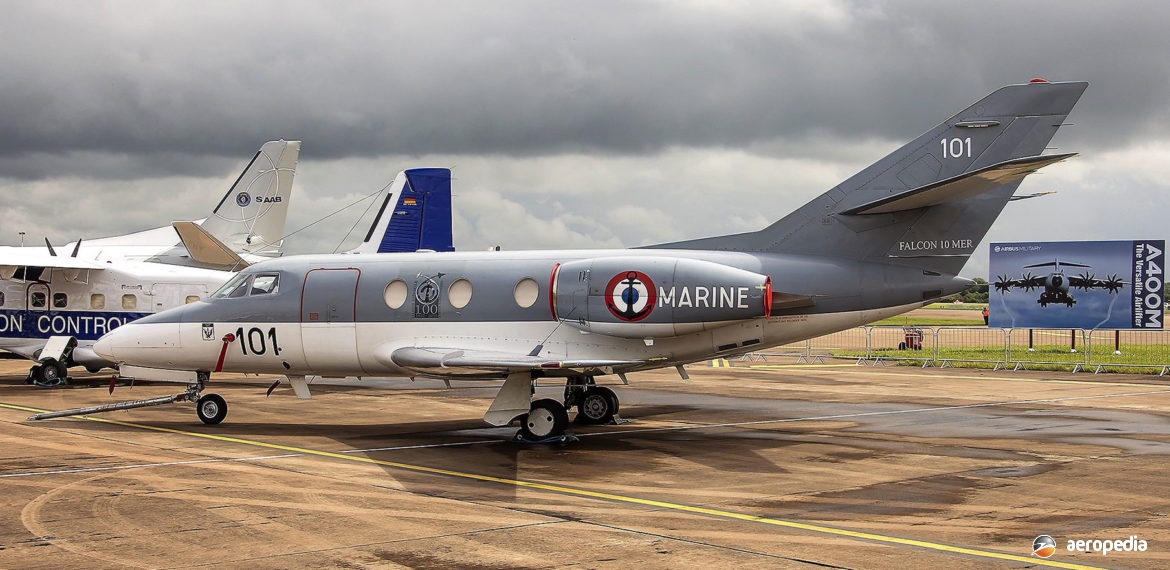Photograph:
Dassault-Breguet Falcon 10 MER 101 at Fairford, United Kingdom in July 2012 (Steven Veigel)
Country of origin:
France
Description:
Business and executive aircraft
Power Plant:
Two 3,230 lbst Garrett AiResearch TFE731-2 turbofans
Specifications:
- Wingspan: 13.08 m (42 ft 11 in)
- Length: 13.85 m (45 ft 5 in)
- Height: 4.61 m (15 ft 1½ in)
- Wing area: 24.1 m² (259 sq ft)
- Max cruising speed at 9,145 m (30,000 ft): 915 km/h (568 mph)
- Cruising speed at 13,716 m (45,000 ft): 796 km/h (495 mph)
- Range with four passengers and 45 mins reserve at 13,716 m (45,000 ft): 3,980 km (2,475 miles)
- Range at max cruising speed at 9,145 m (30,000 ft): 2,405 km (1,495 miles)
- Empty weight: 4,600 kg (10,141 lb)
- Loaded weight: 8.300 kg (18,298 lb)
History:
The Dassault-Breguet Falcon 10, which was also known as the Mystere 10, first appeared in 1969 as a scaled-down Falcon 20. The aircraft accommodated a flight crew of two, with provision for a third crew member on a jump seat. It was aimed at the business and executive role. It could seat four passengers but by the installation of an alternate arrangement eight passengers could be accommodated. This variant was known as the Falcon Model 10A, or the Falcon 10B where ten passenger seats were fitted.
A number of engines were considered for the type including the 2,980 lbst Turbomeca-SNECMA Larzac turbofan, but it was eventually decided to fit the Garrett AiResearch TFE731-2 turbofan. This decision was probably because the majority of sales of this type of aircraft was made on the United States market. At that time the Business and Executive Division of Pan American Airways was the American distributor, and American operators have nearly always desired American-built engines. This latter organisation later became the Falcon Jet Corporation and it placed an initial order for 54 aircraft and options on a further 106, deliveries commencing in November 1973.
The first of two prototypes of the Falcon 10, powered by two General Electric CJ610 turbojets, was flown for the first time on 1 December 1970. The second prototype was flown on 15 October 1971, followed by the first production aircraft on 14 October 1972. When the type was offered to the French Air Force for crew training and liaison duties, two examples were obtained for test and evaluation. From 1982 the Falcon 10 became known as the Falcon 100, new production aircraft having a restyled interior, external heated baggage compartment, an extra window on the right-hand side, and a Collins EFIS-85 CRT system.
A number of Falcon 10s and 100s have been registered in Australia. VH-MEI (c/n 50) was registered to Mount Enid Company Pty Ltd of Perth, WA, on 14 July 1977, was operated by a number of companies before being exported to New Zealand as ZK-WNL but in fact went to the United States as N133FJ.
Other examples included VH-MCX (c/n 134 – ex N589TC, N900T, N209FJ, F-WZGF) which was operated by McCafferty’s Air Charter, Capital Finance Australia, and Wagner Aviation of Toowoomba, QLD, from September 1995 until it became VH-WJW with the latter in April 2005, being operated by CareFlight Queensland, seeing service with CareFlight Medical Services. It was withdrawn from use at Cairns on September 2011.
VH-DJT (c/n 169) was registered to Drayton Investments in June 1981, going to Queensland Aggregates in August 1986, and was exported in May 1988 as N725P.
VH-JDW (c/n 216) was operated by the National Safety Council of Australia, Victorian Division, from November 1988 to May 1989 when ownership was transferred to the Commonwealth Bank and it was exported in October that year as 9M-ATM.
VH-FFB (c/n 17 ex OH-FFB, F-WICS) was registered to Hancock Prospecting Pty Ltd of Nedlands, WA on 7 December 1978 and was exported on 10 March 1982 as N29966.
ZK-MAZ (c/n 213) was a Model 100 operated for a period in 1990 with Goodman Fielder Wattie Ltd and was exported to France as F-GKAE.

